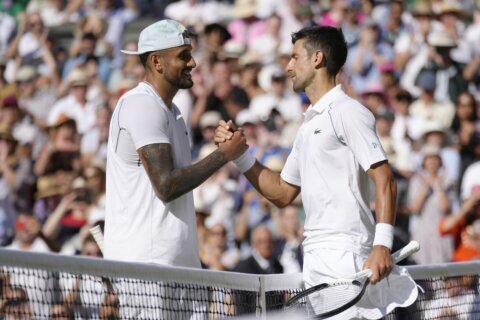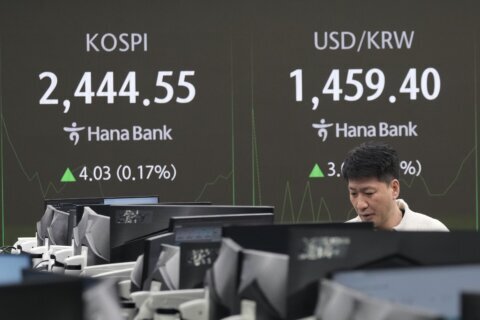It’s inevitable in a Cricket World Cup semifinal between Australia and South Africa that the tied contest in 1999 dominates attention.
For the victors, as captain Pat Cummins said Wednesday, “It’s part of Australian cricket folklore.”
For South Africa, it was another part of a long run of cricket heartbreak.
Australia clinched a spot in the ‘99 final, and went on to easily beat Pakistan at Lord’s for the title, after a mix-up between South Africans Lance Klusener and Allan Donald resulted in a last-over runout that ended the Proteas’ tournament.
“You see the replays,” Cummins said on the eve of the semifinal in Kolkata, when asked about the impact of that game on his current squad, “but obviously none of us were playing the game.”
The South Africans have consigned that result to history, and make the point that some players in their squad weren’t even born when it happened.
Still, the aggressive South Africa lineup is aiming to shrug off the tag of chokers when it takes on the in-form five-time champions for a spot in Sunday’s final.
The infamous run-out in ’99 wasn’t the only time the Proteas have slipped at the knockout stage.
The unlucky run started with the impossible revised target of 22 off one ball in the 1992 semifinal, because of controversial rain rule.
There were the 2007 and 2015 semifinals, too, which only enhanced the burden on each team since.
At this World Cup, it’s no secret that Temba Bavuma’s lineup has struggled to chase down totals even though South Africa placed second — with a better net run-rate than third-place Australia — after both teams finished the league stage 7-2.
The Netherlands sprung one of the biggest upsets in World Cup history when South Africa couldn’t chase down 246 runs in 46 overs. Then India bundled the Proteas out for 83 after putting up 326-5 in a match — also in Kolkata — between the top two teams.
South Africa was also stretched to its limit in two successful chases. Pakistan nearly pulled off a win before Keshav Maharaj and Tabraiz Shamsi got the team over the line by the barest of margins. And Afghanistan claimed seven Proteas wickets before going down by three.
An aggressive batting approach has propelled South Africa into the semis with the likes of Quinton de Kock, Rassie van der Dussen, Aiden Markram and Heinrich Kalssen showing plenty of batting muscle.
De Kock has reserved his best for his last international tournament, with the left-handed opener scoring 591 runs, including 109 against Australia at Lucknow.
Van der Dussen has two centuries and two half centuries while Markram and Klassen also scored rapid hundreds. And with David Miller and Marco Jansen’s ability to accelerate in the death overs, South Africa has covered its batting bases to attack any bowling opposition.
Gerald Coetzee and Jansen have taken the bowling spotlight from more experienced Kagiso Rabada and Lungi Ngidi, while Maharaj’s 14 wickets with his left-arm spin have come at a very economical rate of 4.37.
Coetzee’s 18 wickets in seven games could tilt the balance in his favor and South Africa might not get tempted to opt for wrist spinner Shamsi, who took 2-38 when both teams met in the league stage.
Bavuma has been struggling with a hamstring injury, but the South Africa skipper is expected to recover in time for the game.
Australia had a nervy start when it lost to both India and South Africa, but made an imperious comeback and enters the semifinals on a seven-game winning streak.
That streak was in the balance unexpectedly against Afghanistan, until Glenn Maxwell’s once-in-a-lifetime sort of unbeaten 201 that contained 21 fours and 10 sixes while braving cramps.
David Warner and Mitchell Marsh both have hit centuries, with the 37-year-old Warner scoring 499 runs.
Marsh’s run tally of 426, including his 177 in the last league game, is also among the top 10.
Australia’s main selection headache is whether to include allrounder Marcus Stoinis as the sixth bowling option and use his aggressive batting in the late overs or to opt for Marnus Labuschagne’s solid batting in the middle.
Adam Zampa’s 22 wickets at a strike rate of 21.54 has not only placed the legspinner on top of the bowling charts in the tournament but also played a key role in providing Cummins crucial breakthroughs.
In sharp contrast, the seasoned pace trio of Josh Hazlewood, Cummins and Mitchell Starc are yet to leave an impression with a combined 32 wickets so far.
“I certainly haven’t been at the level I would have liked … or not the same level as the last two World Cups anyway, but now’s a chance at the pointy end.”
With Pakistan fast bowlers finding plenty of reverse swing with the old ball at Kolkata, Starc and Cummins could make things difficult for South Africa’s aggressive batters.
What the Australians have in their favor is experience at this stage.
“We’ve got a lot of guys that have been in this situation before, that have won one-day World Cup, T20 World Cup, various other tournaments in big moments,” Cummins said. “You can draw on that in the middle of the contest. You know what it takes, but you’re not really weighed down by history.”
___
AP cricket: https://apnews.com/hub/cricket
Copyright © 2025 The Associated Press. All rights reserved. This material may not be published, broadcast, written or redistributed.







